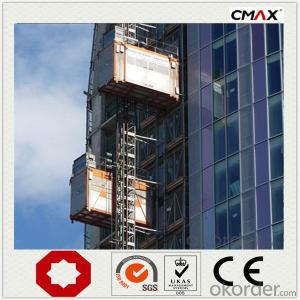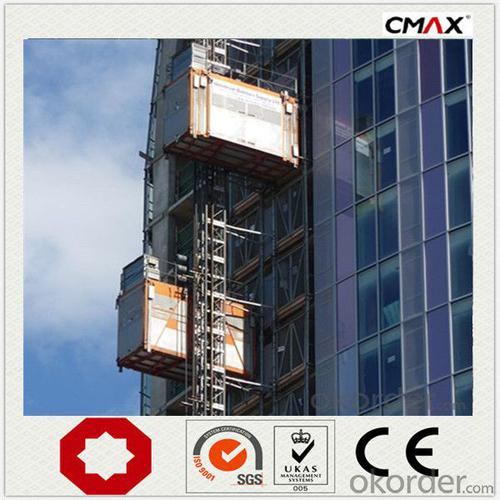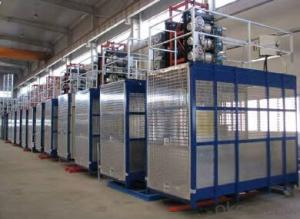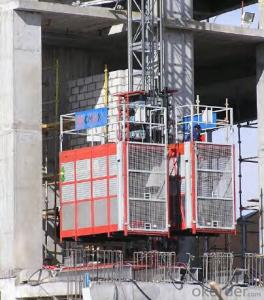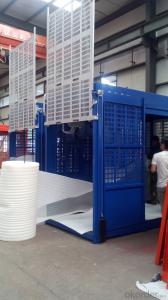Construction Hoist High Tensile Steel SC200
- Loading Port:
- China main port
- Payment Terms:
- TT OR LC
- Min Order Qty:
- 1 unit
- Supply Capability:
- 30 unit/month
OKorder Service Pledge
OKorder Financial Service
You Might Also Like
Specification
Building Hoist Description
Condition: New
Application: Construction
Payload(kg):2000
Lifting Speed(m/min):0~60
Motor Power(kw): 3*15
Safety Device: SAJ40-1.4
Cage: Single
Counterweight: No
Certification: CE,ISO
Place of Origin: China(Mainland)
Model Number: Type:SC200
Packaging & Delivery of Building Hoist
Packaging Detail: Nude package
Delivery Detail: 25-30days
Building Hoist Images

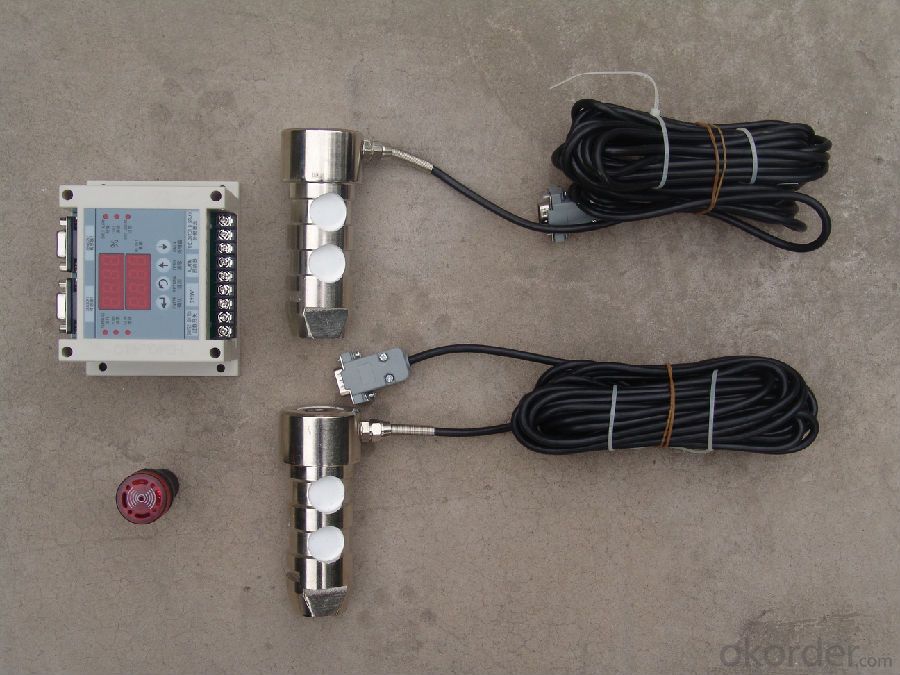
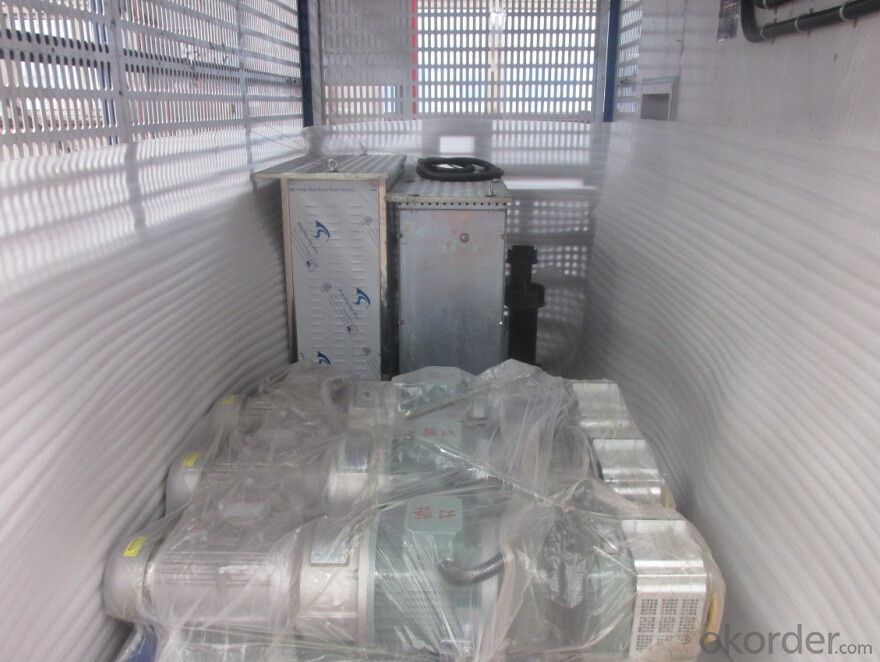
Building Hoist Specifiction
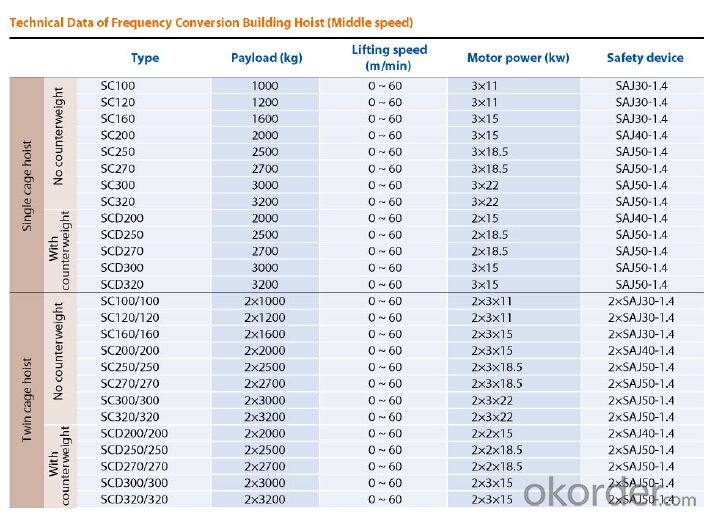
FAQ of Building Hoist
Q: What is the building hoist main purpose?
A: Building hoist equipped with double or single cabin to transport the materials and labors up and down. It's the ideal
construction equipment for vertical transportation in the field of construction.
Q: What is the main structure of building hoist?
A: The P/M construction hoist mainly contains metal structure, driving system, electrical control system, cable guide &
protection system, electrical top crane and safety device.
Q: What is the meaning of the building hoist’s code?
A: Take SC200/200 for example: “SC” stands for rack and pinion hoist, “200/200” stands for double cage and capacity
is 2 tons per cage. “SC200” stands for single cage and capacity is 2 tons.
- Q: Is it possible to use a single automatic building hoist to lift multiple objects simultaneously?
- <p>Yes, an automatic building hoist can be used to lift multiple objects at once, provided that the combined weight of the objects does not exceed the hoist's maximum load capacity. It is crucial to ensure that the hoist is designed for such operations and that all safety precautions are taken to prevent overloading, which can lead to accidents. The hoist should be equipped with a load limiter to automatically cut off power if the load exceeds safe limits, ensuring the safety of the operation.</p>
- Q: This question asks for the method to adjust the tension of ropes or cables in lifting equipment such as a building hoist.
- <p>Adjusting the tension on ropes or cables in lifting equipment like a building hoist involves several steps. First, ensure the equipment is turned off and secured to prevent any accidents. Then, locate the tensioning mechanism, which could be a ratchet, turnbuckle, or a similar device. Gradually adjust the mechanism to tighten or loosen the cable as needed. Use a tension meter to measure the tension and ensure it meets the manufacturer's specifications. Regularly inspect the cables for wear and damage, and replace them if necessary. Always follow the equipment's manual for specific instructions and safety guidelines.</p>
- Q: This question asks for a list of various types of lifting equipment commonly used in the construction industry.
- <p>In construction, various types of lifting equipment are utilized to move heavy materials and structures. These include cranes such as tower cranes, mobile cranes, and crawler cranes, which are versatile and can lift heavy loads to significant heights. Forklifts are used for lifting and moving materials over short distances. Telescopic handlers, also known as cherry pickers, provide both lifting and access capabilities. Hoists are used for lifting smaller loads and are often found in workshops or on construction sites. Derricks are fixed structures used for lifting heavy loads in a specific area. Lifting slings and shackles are used in conjunction with cranes and hoists to secure loads. Finally, aerial work platforms, like scissor lifts and boom lifts, provide elevated access for workers and materials. Each type of lifting equipment serves a specific purpose and is chosen based on the nature of the construction project and the weight and size of the loads to be moved.</p>
- Q: This question seeks to understand the benefits and drawbacks associated with the use of hydraulic building hoists in construction.
- <p>Hydraulic building hoists offer several advantages, including high lifting capacity, smooth and controlled lifting, and lower maintenance costs due to fewer moving parts. They are also energy-efficient and can be easily integrated into existing systems. However, they have some disadvantages. For instance, they can be more expensive to purchase initially compared to other hoist types. Additionally, they may require more space for installation and can be sensitive to extreme temperatures, which might affect performance. Lastly, hydraulic systems can be prone to leaks and require regular fluid checks and maintenance to prevent system failure.</p>
- Q: Is it possible to utilize a building hoist for the purpose of lifting large vehicles?
- <p>Yes, a building hoist can be used to lift large vehicles, but it requires a hoist specifically designed and rated for such heavy loads. It's crucial to ensure that the hoist has the necessary capacity and safety features to handle the weight of the vehicle. Additionally, the operation must be conducted by trained professionals following strict safety protocols to prevent accidents. It's also important to check local regulations and guidelines for lifting operations involving heavy machinery or vehicles.</p>
- Q: Explain the distinctions between electric and manual building hoists, focusing on their operation, efficiency, and use cases.
- <p>Electric building hoists are powered by electricity and offer faster operation, greater efficiency, and the ability to lift heavier loads. They are ideal for large-scale construction projects where rapid movement of materials is necessary. In contrast, manual hoists are operated by hand and are typically smaller, more portable, and require human effort to lift materials. They are suitable for smaller projects or where power supply is limited. Electric hoists are more automated and can be controlled remotely, while manual hoists require constant physical effort and are less efficient in terms of speed and load capacity.</p>
- Q: Is it advisable to use personal lifting equipment without seeking professional advice first?
- <p>No, it is not advisable to use your own lifting equipment without consulting professionals first. Lifting operations can be hazardous and require specific knowledge and expertise to ensure safety. Professionals can assess the weight, stability, and appropriate lifting techniques required for your equipment. They can also provide guidance on safety regulations and the correct use of lifting gear, which is crucial to prevent accidents and injuries. Always consult with experts before undertaking any lifting tasks to ensure compliance with safety standards and to protect yourself and others.</p>
- Q: This question asks for safety precautions that should be taken when using a building hoist, which is a type of lifting equipment used in construction.
- <p>Safety measures for using a building hoist include regular inspections and maintenance, ensuring all safety devices are in good working order, securing all loads properly, and not overloading the hoist. Operators must be trained and certified. Protective barriers should be in place to prevent unauthorized access. Emergency stop switches should be readily accessible. Workers should wear appropriate personal protective equipment, and communication between the hoist operator and those on the ground should be clear and effective. Adhering to these measures helps prevent accidents and ensures the safe operation of the building hoist.</p>
- Q: This question asks about the method to determine the maximum weight a building hoist can safely support.
- <p>Calculating the maximum load capacity of a building hoist involves several factors. First, consider the hoist's mechanical design and the manufacturer's specifications, which provide the rated load capacity. This is the maximum weight the hoist is designed to handle. Next, assess the condition of the hoist, as wear and tear can reduce its capacity. Additionally, consider the strength of the supporting structure and the safety factor, which is typically a multiplier of the rated load capacity to ensure safety. For example, if the hoist is rated for 1000 kg, a safety factor of 1.5 means the actual maximum load should not exceed 667 kg (1000 kg / 1.5). Always consult with engineers and follow local regulations and standards for precise calculations.</p>
- Q: The elevator is banned from using elevators for more than a class of high winds
- More than 6 levels of wind are forbidden to be removed and used. More than 4 levels of wind are not allowed to rise, and more than 6 winds are prohibited.
Send your message to us
Construction Hoist High Tensile Steel SC200
- Loading Port:
- China main port
- Payment Terms:
- TT OR LC
- Min Order Qty:
- 1 unit
- Supply Capability:
- 30 unit/month
OKorder Service Pledge
OKorder Financial Service
Similar products
Hot products
Hot Searches
Related keywords
